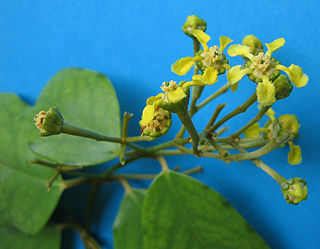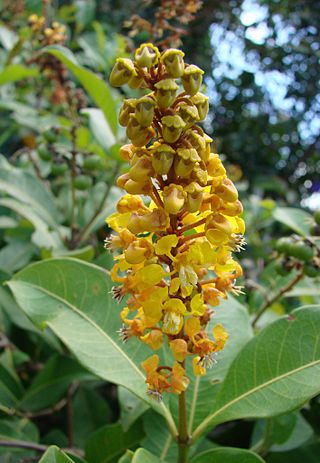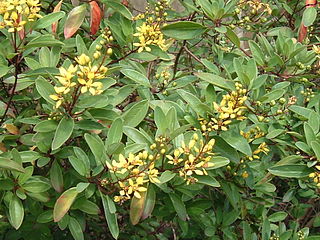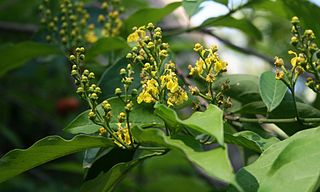
Malpighiaceae is a family of flowering plants in the order Malpighiales. It comprises about 73 genera and 1315 species, all of which are native to the tropics and subtropics. About 80% of the genera and 90% of the species occur in the New World and the rest in the Old World.

Acmanthera is a genus in the Malpighiaceae, a family of about 75 genera of flowering plants in the order Malpighiales. Acmanthera comprises 7 species of trees, shrubs, or subshrubs native to Brazil.

Heteropterys is a genus in the Malpighiaceae, a family of about 75 genera of flowering plants in the order Malpighiales. Heteropterys comprises over 140 species of woody vines, shrubs, and small trees found in the New World tropics and subtropics from northern Mexico and the West Indies to northern Argentina and southeastern Brazil. One widespread, mostly Caribbean species, H. leona, is also found in low wet places along the coast of West Africa from Senegal to Angola.

Byrsonima is one of about 75 genera in the Malpighiaceae, a family of flowering plants in the order Malpighiales. In particular in American English, they are known as locustberries. Another widely seen common name is serrets or serrettes.
Rhynchophora is a genus in the Malpighiaceae, a family of about 75 genera of flowering plants in the order Malpighiales. Rhynchophora comprises two species of slender woody vines native to Madagascar. The distinctive three to four-winged fruit resembles a helicopter and is unique in the family.

Peixotoa is a genus in the Malpighiaceae, a family of about 75 genera of flowering plants in the order Malpighiales. Peixotoa comprises 29 species of vines, shrubs, and subshrubs native to Brazil and adjacent Paraguay and Bolivia.
Thryallis is a genus in the family Malpighiaceae, of scandent shrubs and woody vines native to Brazil and adjacent Paraguay and Bolivia.

Galphimia is a genus in the Malpighiaceae, a family of about 75 genera of flowering plants in the order Malpighiales; the name is an anagram of Malpighia.Galphimia comprises 26 species of large herbs, shrubs, and treelets. Twenty-two species occur in Mexico, one extending into Texas and one ranging to Nicaragua; four species occur in South America, south of the Amazon Basin. Galphimia gracilis is widely cultivated in warm regions throughout the world. Eight species are distinctive in that the petals become stiff and papery, and persist past the stage of fruit maturation.

Bunchosia is a genus in the Malpighiaceae, a family of about 75 genera of flowering plants in the order Malpighiales. It contains roughly 75 species of trees and shrubs, which are native to dry woodlands, savannas, and wet forests. Their range extends from Mexico and the Caribbean to southeastern Brazil and adjacent Argentina. Bunchosia is one of three arborescent genera of Malpighiaceae with fleshy, bird-dispersed fruits.

Mascagnia is a genus in the Malpighiaceae, a family of about 75 genera of flowering plants in the order Malpighiales. The genus Mascagnia comprises about 45 species that occur in diverse habitats from northern Mexico and the Caribbean to northern Argentina and south-eastern Brazil.

Stigmaphyllon is a genus in the Malpighiaceae, a family of about 75 genera of flowering plants in the order Malpighiales. Amazonvine is a common name for species in this genus.
Ectopopterys is a genus in the Malpighiaceae, a family of about 75 genera of flowering plants in the order Malpighiales. Ectopopterys contains only one species of woody vines native to lowland wet forests of Colombia, Ecuador, and Peru.

Galphimia gracilis, a species in the genus Galphimia of the family Malpighiaceae, is native to eastern Mexico. It is widely cultivated in warm regions throughout the world, often under the common names gold shower or shower-of-gold, slender goldshower or sometimes thryallis. In horticultural publications, in the nursery trade, and on websites, this species is commonly but mistakenly referred to as Galphimia glauca, Galphimia brasiliensis, Thryallis glauca, Thryallis gracilis, or often in South America, Thryallis brasiliensis.
Diplopterys is a genus of plants in the Malpighiaceae family.
Jubelina is a genus in the Malpighiaceae, a family of about 75 genera of flowering plants in the order Malpighiales. Jubelina comprises 6 species of woody vines occurring in tropical wet primary and secondary forests of Central America and South America.
Bronwenia is a genus in the Malpighiaceae, a family of about 75 genera of flowering plants in the order Malpighiales. Bronwenia comprises 10 species of shrubs and woody vines native to Mexico, Central America, and South America.
Calcicola is a genus in the Malpighiaceae, a family of about 75 genera of flowering plants in the order Malpighiales. Calcicola comprises 2 species of shrubs or treelets native to Mexico.
Cottsia is a genus in the Malpighiaceae, a family of about 75 genera of flowering plants in the order Malpighiales. Cottsia comprises 3 species of slender twining vines native to northern Mexico and extending into Texas, New Mexico, and Arizona. The species of Cottsia were formerly included in Janusia, a genus of South America.
Dicella is a genus in the Malpighiaceae, a family of about 75 genera of flowering plants in the order Malpighiales. Dicella includes seven species, assigned to two sections. Section Dicella comprises D. bracteosa and D. nucifera, found in southeastern Brazil and adjacent Paraguay and Argentina. Section Macropterys includes D. aciculifera, known only from Costa Rica, and D. conwayi, D. julianii, D. macroptera, and D. oliveirae, all of South America from Colombia south to about 19°S

Gaudichaudia is a genus of flowering plants belonging to the family Malpighiaceae.









